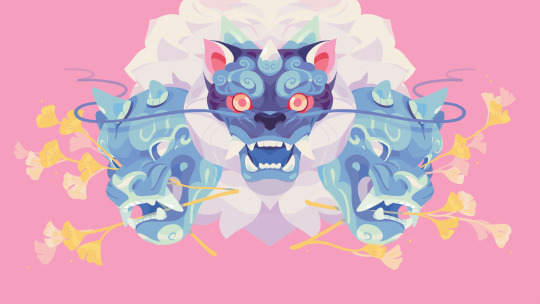#guardianlions
Text
Historians Hate This One Fact About Ancient Fu Dog Statues

Introduction to Fu Dog Statues

Kicking off the captivating tale of the Foo Dog statue, it's important to delve into its roots. Foo Dogs, known as 'Fu Dogs', are classic symbols in Chinese culture, embracing history, craftsmanship, and vibrant folklore. These distinctive statues, formidable yet protective, are traditional elements gracing the entrances of temples, palaces, and homes in China. The statues depict mythical beasts that have an intrinsic appeal due to their rich symbolism and intriguing history, dating back to the Han Dynasty.
Typically, Foo Dog statues look like lions and are often called Chinese guardian lions in the west. This unique lion-like creature, which does not exist in the natural world, combines the formidable fearlessness of a lion with the loyal protectiveness of a dog. It's a potent and fascinating symbol in Chinese culture, amalgamating different elements that appeal to various life aspects.
These sculptures serve multiple purposes, including warding off negative energies, safeguarding spaces, and acting as a talisman for good fortune. Embarking on the exploration of the Foo Dog statue's history, design, and cultural impacts, one uncovers ancient legends and stories that reiterate its timeless value in Chinese culture.
Key Takeaways: Fu Dog Statues
- Fu Dog Statues, also known as Chinese Guardian Lions, have origins dating back to the Han Dynasty.
- These statues are not just artistic pieces but carry deep symbolism of protection, prosperity, and balance in Chinese culture.
- The male and female Fu Dogs represent different aspects, with the male symbolizing dominance and the female symbolizing nurture.
- Fu Dogs play a significant role in Feng Shui, believed to ward off negative energy and bring good luck.
- These statues have been adopted in various Asian cultures and have influenced Western art and architecture.
- A lesser-known fact is the transition of Fu Dog Statues from traditional materials to ceramics during the Tang dynasty, reflecting a cultural shift.
- Fu Dogs are often placed in pairs at entrances of temples and homes, serving as guardians against evil spirits.
- Their global popularity underscores their universal appeal and the widespread appreciation of Eastern cultures.
Definition and Origins

Fu dogs, often known as foo dogs, trace their origins back to the Han dynasty (206 BC - 220 AD) of China. Enigmatic yet captivating, they are not dogs at all, but rather powerful ancient Chinese protective symbols. They are depicted as majestic lion statues, drawing from the Asian cultural reverence for lions as the king of beasts and a symbol of power and protection.
The foo dog lion statue is a fascinating fusion of Buddhist and Taoist cultural influences. It represents the sacred animal lion from Buddhist folklore and embodies the Taoist principles of Yin and Yang, balance and harmony. To the untrained eye, fu dogs may appear identical; however, subtle differences distinguish the male and female figures, symbolizing the complementary forces of Yin and Yang.
Purpose and Symbolism

The foo fu dog statue, prominently visible in the East, is rich in purpose and symbolism. These statues originated from China's Han dynasty, drawing inspiration from ancient lion-based mythology. They were not just mere pieces of art but served an essential function in Chinese society. Their purpose was both spiritual and aesthetic, as these majestic and intricate sculptures were intended to protect individuals and their households from malevolent spirits and people.
Symbolism runs deep in foo fu dog statues. The pair usually consists of a male lion playing with an embroidered ball, symbolic of supremacy over the world, and a female lion nurturing a cub under her paw, representing the cycle of life. The grotesque yet profoundly artistic facial expressions are an embodiment of courage and fearlessness, warding off evil entities.
They also represent power, prosperity, and success, which is why they are ubiquitous in significant structures and residences. Thus, these statues are more than ornamental; they reflect the deeply ingrained Chinese philosophies about balance, protection, and the cyclical nature of life.
The foo fu dog statues are not just pieces of art, but they carry a heavy weight of purpose and symbolism that is deeply rooted in Chinese culture. These statues were originally created during the Han dynasty and have been used for centuries as symbols of protection and prosperity.
• The primary purpose of these statues was to serve as protectors. They were placed at entrances to buildings or homes to ward off evil spirits and people with malicious intent. This protective function is reflected in their fierce facial expressions which embody courage and fearlessness.
• In addition to their protective role, foo fu dog statues also served an aesthetic function. Their intricate designs make them visually appealing, adding a touch of elegance and majesty wherever they are placed.
• Symbolically, the male lion playing with an embroidered ball represents supremacy over the world while the female nurturing a cub under her paw symbolizes life's cyclical nature.
• Another layer of symbolism comes from their appearance; despite being grotesque, these sculptures embody power, prosperity, success - qualities highly valued by Chinese society.
In conclusion:
- Foo Fu Dog Statues represent more than ornamental figures; they reflect profound Chinese philosophies about balance, protection, life cycles.
- Despite having originated several centuries ago during China's Han Dynasty these majestic sculptures remain relevant today due to their deep-rooted significance.
- Their ubiquity in significant structures across East Asia testifies not only to their cultural importance but also underscores how integral these beliefs continue to be within contemporary societies.
Historical Significance
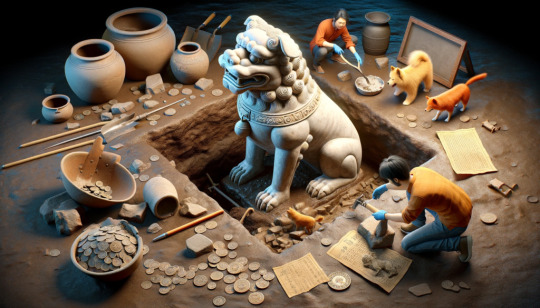
The prominence of the Fu dog, or, more accurately termed, the fu lion statue, can be traced back to Imperial China. Both the Han and Tang dynasties showcased them predominantly, but their significance grew much further during the Ming and Qing dynasties. During these eras, they were seen as the epitome of imperial power, courage, and regality, often strategically placed in important political and religious institutions. Notably, several imperial tombs were adorned with these statues, believed to guard the souls of the deceased rulers against evil and harm in the afterlife.
Han horse-shaped pottery covered with Fu lion designs reveals their artistic significance, highlighting their extensive use as motifs in pottery, paintings, tapestry, and architecture. The fu lion statue also boasted an immense artistic value, symbolizing prosperity and success, often given in the form of gifts to bestow good fortune.
As the culture diffused, so did the prevalence of these statues, spreading across other Asian nations and beyond. Today, they continue to signify courage, prosperity, and protection, maintaining their historical reverence. Their visually captivating aesthetics and deep cultural roots have played an influential role in tastefully blending the past with the present, retaining their historical significance over the centuries.
The Mysterious History of Fu Dogs

Diving deep into the annals of China’s rich and profound history, one will invariably cross paths with numerous stories and legends surrounding large Foo Dog statues. These mystical beasts, also known as Chinese guardian lions, have captivated the interests of scholars, historians, and art enthusiasts alike. Their impressive historical presence in Chinese culture dates back to the Han Dynasty (206 BC–220 AD).
Thought to have profound protective abilities, these large Foo Dog statues were a common sight at imperial palaces, tombs, temples, and homes of nobility. These majestic sculptures served not only as exquisite pieces of art but also as totems believed to ward off menacing spirits.
However, beyond the visual grandeur of large Foo Dog statues, lies a trove of inconceivable mysteries and untold stories waiting to be unearthed. The origins of these mythical creatures have always been a subject of debate, considering how deeply they have been embedded in Chinese folklore and mythology. Some theories suggest that they were inspired by Indian culture, while others propose their roots in Persian or Greek art.
Ancient Chinese epics discuss them as celestial beings, while many believe they were modeled after native dogs—one has to carefully sift through the layers of history to discern the factual evidence from myths. Nonetheless, the fascination with their undeniable historical significance keeps the enigma of Foo Dogs alive in the hearts of historians, writers, and beholders alike.
Ancient Chinese Legends
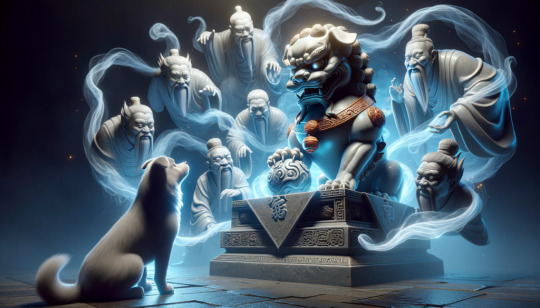
Steeped in deep traditions and narrated through generations, the folklore and legends surrounding the Chinese Foo Dog statues hold an exceptional mystique in ancient Chinese legends. They are not simply decorative sculptures but hold enormous cultural and symbolic significance.
It is said that these ancient guardians originated from the Han Dynasty, around 206 BCE to 220 AD. An intriguing aspect of these legends is that despite their commonly referred name 'Fu Dogs,' they are not dogs at all. Instead, they are mythical beasts, known in Chinese as Shi, symbolizing power and protection.
In ancient Chinese legends, Shi were believed to have an incredibly protective nature and the presence of their statues were seen as potent filters of bad fortune or malicious spirits. They stood as markers of divine power and protection at the gates of imperial palaces, government offices, temples, tombs, and homes of the affluent.
The distinctive features of the Chinese Foo Dog statues, with their menacing expressions and imposing physique, depict a fierce protective spirit. Their legend summons an image of fearless defenders and guardians, an enduring aspect that has been etched deeply in the legacy of ancient Chinese folklore.
Fu Dog Mythology and Folklore

Immerse deeply into the heart of Chinese folklore, and you'll encounter many tales centering around outdoor Fu Dog statues. Also known as Fu dogs or Lion dogs, these creatures have an enticing blend of the lion's majestic power and the loyal canine's protective spirit. Outdoor Fu Dog statues have a strong symbolic presence in many narratives, often credited with warding off evil spirits and welcoming positive energy at the entrances of homes and temples. This is why they are frequently seen as an essential part of Chinese architectural aesthetic, with prominence at the gate of monasteries, temples and palaces, as well as private villas and estates.
The folklore surrounding these mythical beings is rich and varied. Some stories depict them as menacing creatures whose sole purpose is to scare away evil spirits. Others portray them as nurturing creatures connected with fertility and abundance. The Fu dogs, usually depicted in pairs, are thus seen as the perfect balance of yin and yang energies, representing the dual forces that harmoniously regulate the universe's movement.
Often, the male Fu dog is portrayed playing with a ball, symbolizing the world's unity, while the female Fu dog is seen with a cub, symbolizing the cycle of life. Such visual storytelling invokes a sense of wonder, effortlessly tying together elements of nature, cosmology, and human existence in a beautifully succinct pictorial narrative.
Archaeological Evidence

Archaeological excavations in China have provided a trove of clues regarding the history and significance of the Fu Dog or Guardian Lion across various dynasties. Notably, amongst various artefacts, jade foo dogs have emerged as a recurrent theme, standing out for their intricate craftsmanship and rich symbolic value. The earliest evidence of jade foo dogs dates back to the Han Dynasty (206 BC–220 AD), when the practice of carving religious and mythological figures from jade was flourishing. Some historians speculate that the jade foo dogs of the Han era were not just objects of beauty, but also spiritual talismans believed to ward off evil spirits and bring prosperity.
In recent times, the Mausoleum of the Nanyue King in Guangzhou City, unearthed a significant number of jade artifacts including jade foo dogs, dated back to the Western Han period. These discoveries, carefully preserved and studied, help us understand the antiquity of foo dogs in Chinese culture as well as underlying historical craftsmanship techniques.
Further, it sheds light on the socio-cultural dynamics of the period, indicating how such artifacts were predominantly associated with power and protection. The meticulous detailing of these jade foo dogs underscores the high level of finesse that ancient Chinese artisans possessed and the symbolism that such artifacts carried in their era.
The Fact Historians Don't Want You to Know

Despite the well-documented history of Fu Dogs in Chinese culture and tradition, there exists a lesser-known fact that ceramic sculptures of these creatures carry a unique significance. When Fu Dog statues first appeared, they were made from bronze, stone, or wood, attributing to both the artistry and the resources available during the different dynasties. However, the craft saw a significant revolution at the onset of the Tang dynasty when foo dogs ceramic gained widespread popularity.
The rise in the foo dogs ceramic during the Tang dynasty is said to be due to the technological advancements in pottery, and ceramics at that time. Simultaneously, this trend reflected the increasing openness of Tang society, gradually moving away from the rigidly hierarchical Shang and Zhou societies and expressing this liberal phase through its art forms.
This historical shift, though quite compelling, is often understated, possibly because it disrupts the more engrained narrative of Fu Dogs as symbols of imperial power and authority. Instead, it highlights a period of evolution, when societal changes influenced art and culture in profound ways. This transformation is encapsulated in the transition from using traditional materials to ceramics for Fu Dog statues, a fact intriguingly unknown to many.
Fu Dog Design and Craftsmanship

Fu Dog Statues are distinguished by a meticulously detailed design and superior craftsmanship. This intricacy can be attributed to the centuries-old Chinese tradition of stone carving and pottery-making. The exquisite detail of Fu Dogs, from their curly mane to the wide-open jaws displaying sharp teeth, embodies not just aesthetics, but also folklore and mysticism tied to the creature.
The common physical features of Fu Dogs include a lion-like appearance, a bushy tail, and a protective and fierce demeanor. Often the Fu Dog sculpture depicts a pair, comprising one male with a ball under his paw (symbolizing the world's unity) and one female, with a cub under her paw (symbolizing nurture and the cycle of life).
Stylistic variations of Fu Dogs vary greatly based on region and era. Despite this, elements like the paw on the symbolic objects, aggressive expressions, and muscular, lion-like bodies remain constant in traditional designs. Fu Dogs are typically carved from marble, jade, bronze, or wood. Every material has its own significance, from purity symbolized by Jade to strength and durability associated with Bronze and Wood.
Sometimes the statues are enhanced with more detailed ornamentation, Oftentimes, the statues are painted or gilded to make them more visually striking. These intricacies in design and craftsmanship highly contribute to Fu Dogs' appreciation as exquisite pieces of art and cultural symbols.
Common Physical Features

Fu Dog statues are typically portrayed as majestic and ferocious mythical beasts, reflecting a harmonious blend of strength, elegance, and spirituality. The most universally recognized physical attributes consist of a bulging, muscular body, thick mane, and widely-opened jaws that reveal sharp, imposing teeth. They are typically shown with one foot raised and placed on an object. This object varies - it might be a cub depicting nurturance if the creature is female, or a ball symbolizing command and authority if the creature is male.
Coupled with the captivating presence of finely detailed fur, the piercing eyes of Fu Dogs contribute to their grandiosity, giving them an aura of wisdom curled with intensity. Another characteristic element of Fu Dogs is the vibrant and intricate adornments and the surface etchings on them.
Read the full article
#ancientChina#artandarchitecture#Asianart#Chineseculture#ChineseGuardianLions#Chinesemythology#culturalheritage#Easternphilosophies#FengShui#FuDogStatues#FuDogStatueshistory#globalinfluence#guardianlions#HanDynasty#TangDynasty
1 note
·
View note
Photo
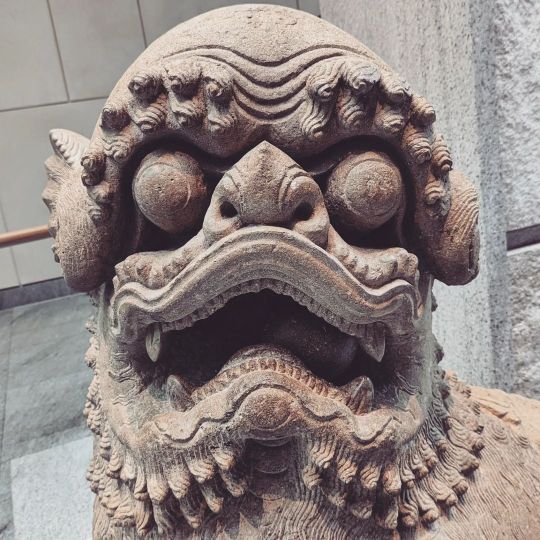
🦁🗿 - 📃 @PeabodyEssex - #lion #statue #stoneCarving #Chinese #QingDynasty #guardianLions #清朝 #石獅 #art #museum #SalemMA #Boston (at Peabody Essex Museum) https://www.instagram.com/p/CerVmodPj3A/?igshid=NGJjMDIxMWI=
0 notes
Photo
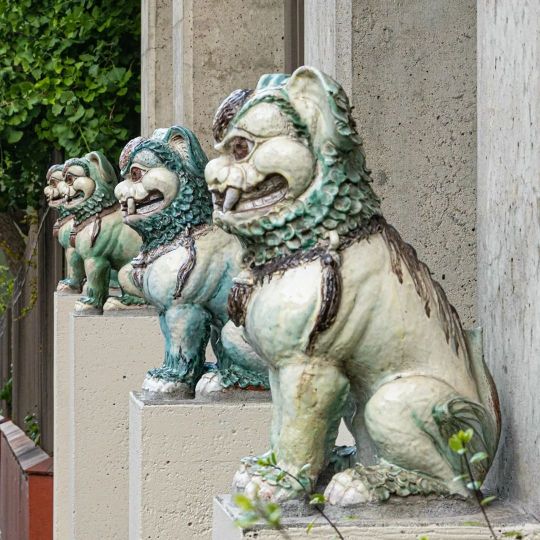
One culture 's #religion is the next culture's #mythology. Humans have always believed in the beings with extra-human powers. The most important aspect of this is how it shows what's universally revered, the importance of #family. Whether you are born into or choose your family, we all wish for them to be protected. This desire to protect comes from #love as a root of all action. When you travel, look at the stories written in the #iconography of faith. Dig down to the roots where you will find commonality among people. It is only by doing so that we will be able to reach out to people unlike ourselves. Many tribes make a nation. #culture #similar #different #yinandyang #foodog #guardianlion #fudog #loveoneanother #loveeachother #community #unity #cometogether #chinatown #sanfran #sf #sanfrancisco #architecture #builtenvironment #architecturephotography #archtectural #travel #tourism #travelphotography #getoutthere #gosomewhere https://www.instagram.com/p/ChaduBypo2l/?igshid=NGJjMDIxMWI=
#religion#mythology#family#love#iconography#culture#similar#different#yinandyang#foodog#guardianlion#fudog#loveoneanother#loveeachother#community#unity#cometogether#chinatown#sanfran#sf#sanfrancisco#architecture#builtenvironment#architecturephotography#archtectural#travel#tourism#travelphotography#getoutthere#gosomewhere
0 notes
Text

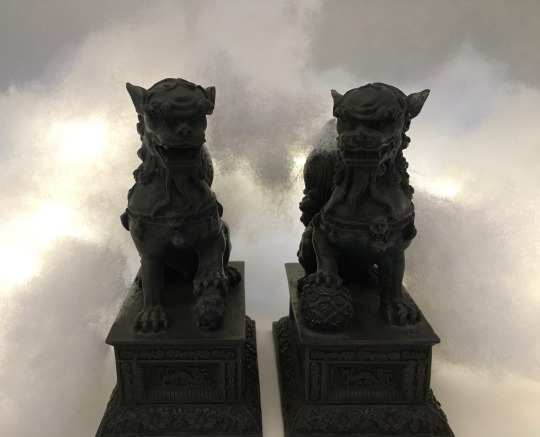
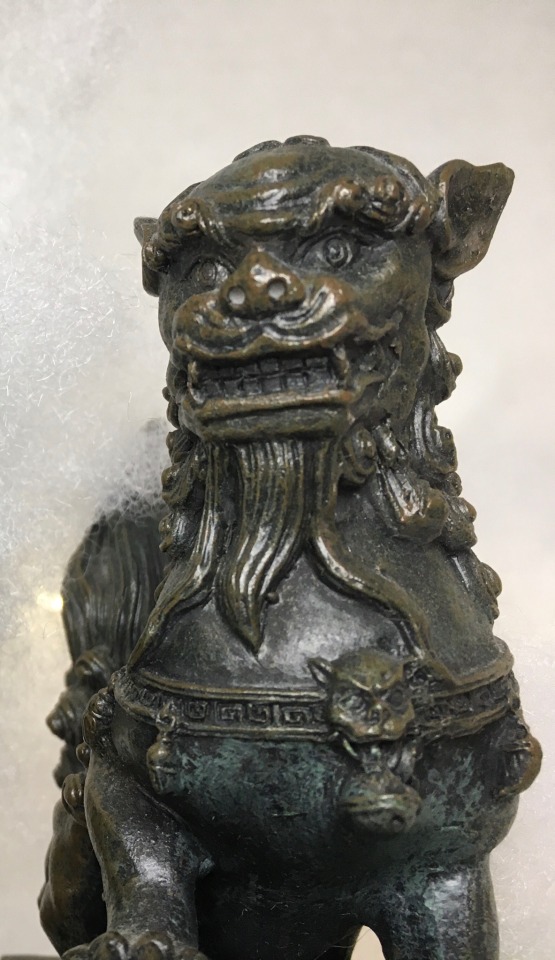

I tried to find info, not very hard, but could not ;P These two were sold as a set from Teavanna many years ago. Like, before Starbucks bought the company many years.
#collection #collectables #toy #toys #toycollector #collectabletoys #artcollectables #instatoy #toystagram #toyphotography #monster #monsters #sculpture #chineselion #foodog #shishi #ceramic #guardianlion #mythology
#monsters#collection#collectables#foo dog#chinese mythology#chinese lion#guardian lion#monster#ceramic
6 notes
·
View notes
Photo
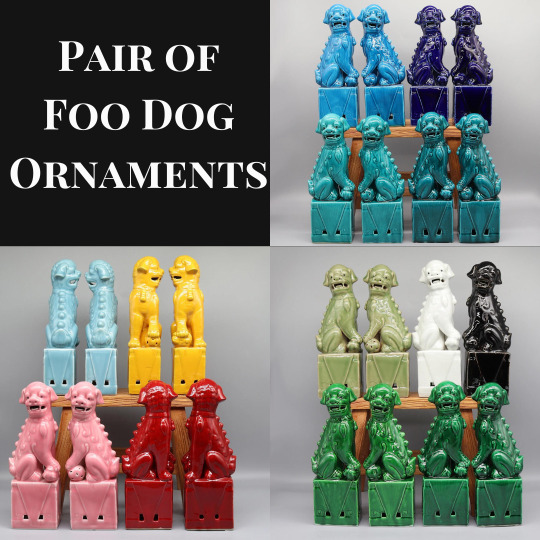
Foo dogs are symbolic, protective statues, and they are designed in pairs — one is female, the other is male. The female represents yin, and symbolically protects the people dwelling inside the home, while the male statue, representing yang, protects the structure itself (Source: Houzz) Shop Our Pair Of Foo Dog Ornaments Today at Floral Fawna. FREE shipping on all worldwide orders. 15% OFF all items storewide. #foodog #dog #chinese #dogs #china #ornament #sculpture #figurine #figure #homeware #home #gift #giftshop #giftidea #buddhadog #guardianlion #ceramic #lion #art
0 notes
Text
Invisible Gate ~ Honouring a Community

(Rendering and original ‘Foo Dog’ or lion at the Harbin Gate - Studio F. Minus)
Invisible, but resonant, our personal, and collective histories, inform communities and day-to-day lives. They manifest through community markers – activity hubs, communal spaces, and symbolic places. When these tangible markers disappear, whether intentionally or intentionally, communities can experience a sense of grief and trauma. Invisible Gate, a new public artwork currently under development by Canadian collective Studio F. Minus, scrutinizes these issues and displays personal artifacts to illustrate the many layers of meaning and time within the Boyle Street community.
When completed, says lead artist Mitchell F. Chan, the artwork will serve as a container for those histories and stories. “The artwork is a pair of stylized lion sculptures created from layers of clear acrylic. What we’re doing right now is going around and asking people in the community to contribute objects that have symbolic value to them. We take a 3D scan of [the object], which we will use to create reproductions of the objects. Those items will be embedded in the sculpture layers. The finished sculptures will be reminiscent of an archeological dig site – you see the layers of people who’ve existed in this community.”
youtube
(Artists’ scanning apparatus in action - video, EAC)
When creating the initial project proposal Chan, and partner Brad Hindson, was inspired by world events and local news. “We did some research and looked a little more into what’s going on with this site and how the development of the neighbourhood was impacting the community – there’s a real story to tell on this site.”
Chan says the most significant local news story about the Boyle Street / South China Town neighbourhood was the removal of the Harbin Gate and accompanying lion sculptures to make way for LRT construction. The removal of these “symbolic markers of a neighbourhood” coincided with protests against, and removal of, public sculptures and monuments in the American South – the artists were eager to engage these issues.
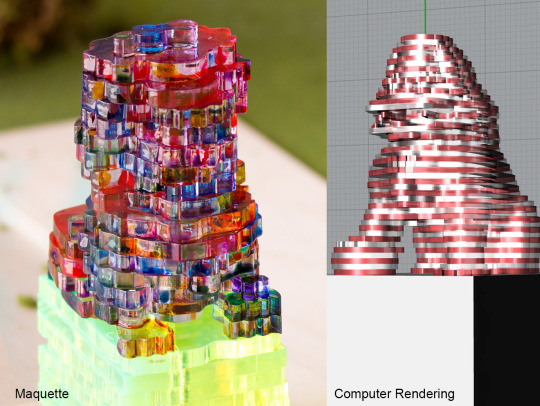
(These images give an idea of how the finished sculpture may look - Studio F. Minus)
The interactive nature of Invisible Gate is an important element running through Studio F. Minus’s artistic practice. Their artist statement says, in part, “[our artworks] through their clarity and accessibility to viewers, transmit a renewed excitement and different appreciation of the world our artwork inhabits.” Invisible Gate invites reflection.
“[What] we choose to commemorate or monumentalize in our public spaces matters. It makes a declaration, a very visible representation of ‘our’ values as a society or community. However, if what we display matters, then it follows that what we take away matters as well. Erasing something symbolic that has a physical presence in a neighbourhood, does say something about how you feel about the value of a community.”
Therefore, the starting place for Invisible Gate, continues Chan, was to, “create an artwork in that symbol’s place that says, ‘you are counted’ that is a symbolic record of your community, where your history matters.”

(Lead artist Mitchell F. Chan with community liaison Shawn Tse - photo, Edmonton Arts Council)
The desire to make sure people are counted, means that Chan, and community liaison Shawn Tse have taken a very open approach to collecting the artifacts “…[they] can be anything – something obviously precious, or something you have on your person at that time. Your story, which we will record, can be a long history or a just token that you are here.”
The approach also recognizes how neighbourhoods like Boyle Street evolve, and how markers can be imbued with multiple meanings.
“Those lions have a different personal connection to people from different backgrounds. It’s incredible to me how we end up sharing our symbols and sharing our markers. I wanted to think about this site as having all different types of people and that this site has room for everybody’s personal connections and memories. People come here from so many backgrounds; they work here, they live here, or they hang out or they visit. and they all engage and interact with the symbols that are present in this community.”
Artists Mitchell F. Chan and Shawn Tse will be collecting stories and scanning artifacts at the EAC Community Public Art Picnic this Saturday, June 8, at Boyle Street Plaza (9538 103A avenue). The event runs from 1:00-4:00pm. There will be live entertainment, mahjong lessons, games, free refreshments, a mini public art tour, and more! Visit the Event Page for details.
#yegpublicart#yegart#studiofminus#canadianart#canadianpublicart#boylestreet#chinatown#yeglrt#lrt#revitalization#art#guardianlions#harbingate
1 note
·
View note
Photo

A tea house named after the 15th century Chinese explorer and navigator Cheng Ho. #chinese #traditional #architecture #bamboo #guardianlions #liondogs #fudogs #chenghoteahouse #cyteahouse #blacksmithstreet #jalantukangbesi #malacca #melaka #malaysia #westmalaysia #southeastasia #asia #discovermelaka #exploremelaka #fabulousmelaka #visitmelaka #cuticutimalaysia #malaysiatrulyasia #tourismmalaysia #discovermalaysia #exploremalaysia #visitmalaysia #visitseasia #visitsoutheastasia (at Cheng Ho Tea House & Vegetarian Restaurant 郑和素食茶馆) https://www.instagram.com/p/Ccl580itQLH/?igshid=NGJjMDIxMWI=
#chinese#traditional#architecture#bamboo#guardianlions#liondogs#fudogs#chenghoteahouse#cyteahouse#blacksmithstreet#jalantukangbesi#malacca#melaka#malaysia#westmalaysia#southeastasia#asia#discovermelaka#exploremelaka#fabulousmelaka#visitmelaka#cuticutimalaysia#malaysiatrulyasia#tourismmalaysia#discovermalaysia#exploremalaysia#visitmalaysia#visitseasia#visitsoutheastasia
0 notes
Photo
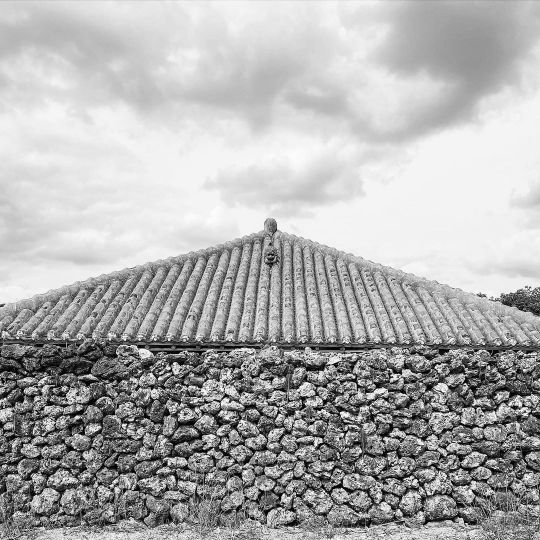
“ꜱʜɪꜱᴀꜱ ɢʀᴀʙʙᴇᴅ ᴛʜᴇ ᴘᴏꜱɪᴛɪᴏɴ ᴏꜰ ᴛʜᴇ ᴄᴇɴᴛᴇʀ ʙᴇᴄᴏᴍᴇꜱ ᴀ ɢᴇɴᴇʀᴀʟ ᴇʟᴇᴄᴛɪᴏɴ ꜰɪʀꜱᴛ ᴘʟᴀᴄᴇ” #shisa #guardianlions #akb48 #idol #wallart #nobuyoshiaraki #naomiosaka #shuntarotanikawa #pattismith #ichiroyamaguchi #reikawakubo #carharttwip #supreme #daidomoriyama #commedesgarcons #photography #kaws #futura2000 #fragmentdesign #hiroshifujiwara #virgilabloh #nigo #louisvuitton #iphonephotography #hypebeast #highsnobiety #taketomiisland #unprecedent #sidelinetokyo #jamfromwkym (竹��島) https://www.instagram.com/p/CMzx5exBsoo/?igshid=1x19ur7s6tjaj
#shisa#guardianlions#akb48#idol#wallart#nobuyoshiaraki#naomiosaka#shuntarotanikawa#pattismith#ichiroyamaguchi#reikawakubo#carharttwip#supreme#daidomoriyama#commedesgarcons#photography#kaws#futura2000#fragmentdesign#hiroshifujiwara#virgilabloh#nigo#louisvuitton#iphonephotography#hypebeast#highsnobiety#taketomiisland#unprecedent#sidelinetokyo#jamfromwkym
1 note
·
View note
Photo

I have finally finished this #artproject These two cute #guardianlions will go to my niece to guard her throughout her whole life #originalartwork #artforkids #abstractart #abstractpainting #acryliconcanvas #acrylicpainting #winsorandnewton #liquitex #acrylfarbe #acrylmalerei #kunst #kunstfürkinder #shisa #guardiandog #wächterhund https://www.instagram.com/p/CE7L0Shhx3x/?igshid=1l19l7018wsix
#artproject#guardianlions#originalartwork#artforkids#abstractart#abstractpainting#acryliconcanvas#acrylicpainting#winsorandnewton#liquitex#acrylfarbe#acrylmalerei#kunst#kunstfürkinder#shisa#guardiandog#wächterhund
0 notes
Text
Historians Hate This One Fact About Ancient Fu Dog Statues

Introduction to Fu Dog Statues

Kicking off the captivating tale of the Foo Dog statue, it's important to delve into its roots. Foo Dogs, known as 'Fu Dogs', are classic symbols in Chinese culture, embracing history, craftsmanship, and vibrant folklore. These distinctive statues, formidable yet protective, are traditional elements gracing the entrances of temples, palaces, and homes in China. The statues depict mythical beasts that have an intrinsic appeal due to their rich symbolism and intriguing history, dating back to the Han Dynasty.
Typically, Foo Dog statues look like lions and are often called Chinese guardian lions in the west. This unique lion-like creature, which does not exist in the natural world, combines the formidable fearlessness of a lion with the loyal protectiveness of a dog. It's a potent and fascinating symbol in Chinese culture, amalgamating different elements that appeal to various life aspects.
These sculptures serve multiple purposes, including warding off negative energies, safeguarding spaces, and acting as a talisman for good fortune. Embarking on the exploration of the Foo Dog statue's history, design, and cultural impacts, one uncovers ancient legends and stories that reiterate its timeless value in Chinese culture.
Key Takeaways: Fu Dog Statues
- Fu Dog Statues, also known as Chinese Guardian Lions, have origins dating back to the Han Dynasty.
- These statues are not just artistic pieces but carry deep symbolism of protection, prosperity, and balance in Chinese culture.
- The male and female Fu Dogs represent different aspects, with the male symbolizing dominance and the female symbolizing nurture.
- Fu Dogs play a significant role in Feng Shui, believed to ward off negative energy and bring good luck.
- These statues have been adopted in various Asian cultures and have influenced Western art and architecture.
- A lesser-known fact is the transition of Fu Dog Statues from traditional materials to ceramics during the Tang dynasty, reflecting a cultural shift.
- Fu Dogs are often placed in pairs at entrances of temples and homes, serving as guardians against evil spirits.
- Their global popularity underscores their universal appeal and the widespread appreciation of Eastern cultures.
Definition and Origins

Fu dogs, often known as foo dogs, trace their origins back to the Han dynasty (206 BC - 220 AD) of China. Enigmatic yet captivating, they are not dogs at all, but rather powerful ancient Chinese protective symbols. They are depicted as majestic lion statues, drawing from the Asian cultural reverence for lions as the king of beasts and a symbol of power and protection.
The foo dog lion statue is a fascinating fusion of Buddhist and Taoist cultural influences. It represents the sacred animal lion from Buddhist folklore and embodies the Taoist principles of Yin and Yang, balance and harmony. To the untrained eye, fu dogs may appear identical; however, subtle differences distinguish the male and female figures, symbolizing the complementary forces of Yin and Yang.
Purpose and Symbolism

The foo fu dog statue, prominently visible in the East, is rich in purpose and symbolism. These statues originated from China's Han dynasty, drawing inspiration from ancient lion-based mythology. They were not just mere pieces of art but served an essential function in Chinese society. Their purpose was both spiritual and aesthetic, as these majestic and intricate sculptures were intended to protect individuals and their households from malevolent spirits and people.
Symbolism runs deep in foo fu dog statues. The pair usually consists of a male lion playing with an embroidered ball, symbolic of supremacy over the world, and a female lion nurturing a cub under her paw, representing the cycle of life. The grotesque yet profoundly artistic facial expressions are an embodiment of courage and fearlessness, warding off evil entities.
They also represent power, prosperity, and success, which is why they are ubiquitous in significant structures and residences. Thus, these statues are more than ornamental; they reflect the deeply ingrained Chinese philosophies about balance, protection, and the cyclical nature of life.
The foo fu dog statues are not just pieces of art, but they carry a heavy weight of purpose and symbolism that is deeply rooted in Chinese culture. These statues were originally created during the Han dynasty and have been used for centuries as symbols of protection and prosperity.
• The primary purpose of these statues was to serve as protectors. They were placed at entrances to buildings or homes to ward off evil spirits and people with malicious intent. This protective function is reflected in their fierce facial expressions which embody courage and fearlessness.
• In addition to their protective role, foo fu dog statues also served an aesthetic function. Their intricate designs make them visually appealing, adding a touch of elegance and majesty wherever they are placed.
• Symbolically, the male lion playing with an embroidered ball represents supremacy over the world while the female nurturing a cub under her paw symbolizes life's cyclical nature.
• Another layer of symbolism comes from their appearance; despite being grotesque, these sculptures embody power, prosperity, success - qualities highly valued by Chinese society.
In conclusion:
- Foo Fu Dog Statues represent more than ornamental figures; they reflect profound Chinese philosophies about balance, protection, life cycles.
- Despite having originated several centuries ago during China's Han Dynasty these majestic sculptures remain relevant today due to their deep-rooted significance.
- Their ubiquity in significant structures across East Asia testifies not only to their cultural importance but also underscores how integral these beliefs continue to be within contemporary societies.
Historical Significance
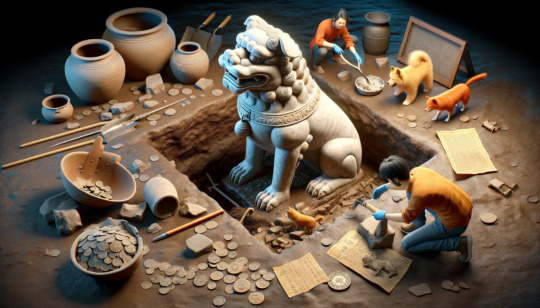
The prominence of the Fu dog, or, more accurately termed, the fu lion statue, can be traced back to Imperial China. Both the Han and Tang dynasties showcased them predominantly, but their significance grew much further during the Ming and Qing dynasties. During these eras, they were seen as the epitome of imperial power, courage, and regality, often strategically placed in important political and religious institutions. Notably, several imperial tombs were adorned with these statues, believed to guard the souls of the deceased rulers against evil and harm in the afterlife.
Han horse-shaped pottery covered with Fu lion designs reveals their artistic significance, highlighting their extensive use as motifs in pottery, paintings, tapestry, and architecture. The fu lion statue also boasted an immense artistic value, symbolizing prosperity and success, often given in the form of gifts to bestow good fortune.
As the culture diffused, so did the prevalence of these statues, spreading across other Asian nations and beyond. Today, they continue to signify courage, prosperity, and protection, maintaining their historical reverence. Their visually captivating aesthetics and deep cultural roots have played an influential role in tastefully blending the past with the present, retaining their historical significance over the centuries.
The Mysterious History of Fu Dogs

Diving deep into the annals of China’s rich and profound history, one will invariably cross paths with numerous stories and legends surrounding large Foo Dog statues. These mystical beasts, also known as Chinese guardian lions, have captivated the interests of scholars, historians, and art enthusiasts alike. Their impressive historical presence in Chinese culture dates back to the Han Dynasty (206 BC–220 AD).
Thought to have profound protective abilities, these large Foo Dog statues were a common sight at imperial palaces, tombs, temples, and homes of nobility. These majestic sculptures served not only as exquisite pieces of art but also as totems believed to ward off menacing spirits.
However, beyond the visual grandeur of large Foo Dog statues, lies a trove of inconceivable mysteries and untold stories waiting to be unearthed. The origins of these mythical creatures have always been a subject of debate, considering how deeply they have been embedded in Chinese folklore and mythology. Some theories suggest that they were inspired by Indian culture, while others propose their roots in Persian or Greek art.
Ancient Chinese epics discuss them as celestial beings, while many believe they were modeled after native dogs—one has to carefully sift through the layers of history to discern the factual evidence from myths. Nonetheless, the fascination with their undeniable historical significance keeps the enigma of Foo Dogs alive in the hearts of historians, writers, and beholders alike.
Ancient Chinese Legends
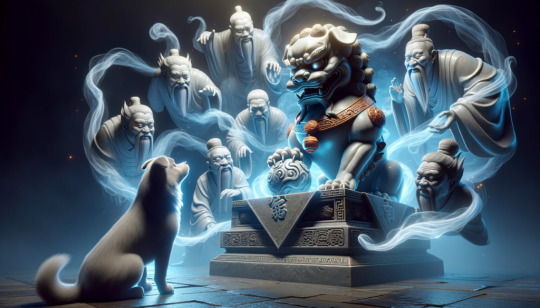
Steeped in deep traditions and narrated through generations, the folklore and legends surrounding the Chinese Foo Dog statues hold an exceptional mystique in ancient Chinese legends. They are not simply decorative sculptures but hold enormous cultural and symbolic significance.
It is said that these ancient guardians originated from the Han Dynasty, around 206 BCE to 220 AD. An intriguing aspect of these legends is that despite their commonly referred name 'Fu Dogs,' they are not dogs at all. Instead, they are mythical beasts, known in Chinese as Shi, symbolizing power and protection.
In ancient Chinese legends, Shi were believed to have an incredibly protective nature and the presence of their statues were seen as potent filters of bad fortune or malicious spirits. They stood as markers of divine power and protection at the gates of imperial palaces, government offices, temples, tombs, and homes of the affluent.
The distinctive features of the Chinese Foo Dog statues, with their menacing expressions and imposing physique, depict a fierce protective spirit. Their legend summons an image of fearless defenders and guardians, an enduring aspect that has been etched deeply in the legacy of ancient Chinese folklore.
Fu Dog Mythology and Folklore

Immerse deeply into the heart of Chinese folklore, and you'll encounter many tales centering around outdoor Fu Dog statues. Also known as Fu dogs or Lion dogs, these creatures have an enticing blend of the lion's majestic power and the loyal canine's protective spirit. Outdoor Fu Dog statues have a strong symbolic presence in many narratives, often credited with warding off evil spirits and welcoming positive energy at the entrances of homes and temples. This is why they are frequently seen as an essential part of Chinese architectural aesthetic, with prominence at the gate of monasteries, temples and palaces, as well as private villas and estates.
The folklore surrounding these mythical beings is rich and varied. Some stories depict them as menacing creatures whose sole purpose is to scare away evil spirits. Others portray them as nurturing creatures connected with fertility and abundance. The Fu dogs, usually depicted in pairs, are thus seen as the perfect balance of yin and yang energies, representing the dual forces that harmoniously regulate the universe's movement.
Often, the male Fu dog is portrayed playing with a ball, symbolizing the world's unity, while the female Fu dog is seen with a cub, symbolizing the cycle of life. Such visual storytelling invokes a sense of wonder, effortlessly tying together elements of nature, cosmology, and human existence in a beautifully succinct pictorial narrative.
Archaeological Evidence
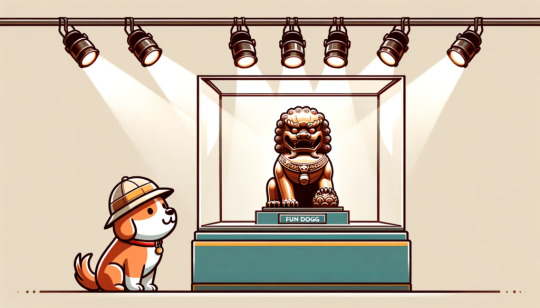
Archaeological excavations in China have provided a trove of clues regarding the history and significance of the Fu Dog or Guardian Lion across various dynasties. Notably, amongst various artefacts, jade foo dogs have emerged as a recurrent theme, standing out for their intricate craftsmanship and rich symbolic value. The earliest evidence of jade foo dogs dates back to the Han Dynasty (206 BC–220 AD), when the practice of carving religious and mythological figures from jade was flourishing. Some historians speculate that the jade foo dogs of the Han era were not just objects of beauty, but also spiritual talismans believed to ward off evil spirits and bring prosperity.
In recent times, the Mausoleum of the Nanyue King in Guangzhou City, unearthed a significant number of jade artifacts including jade foo dogs, dated back to the Western Han period. These discoveries, carefully preserved and studied, help us understand the antiquity of foo dogs in Chinese culture as well as underlying historical craftsmanship techniques.
Further, it sheds light on the socio-cultural dynamics of the period, indicating how such artifacts were predominantly associated with power and protection. The meticulous detailing of these jade foo dogs underscores the high level of finesse that ancient Chinese artisans possessed and the symbolism that such artifacts carried in their era.
The Fact Historians Don't Want You to Know
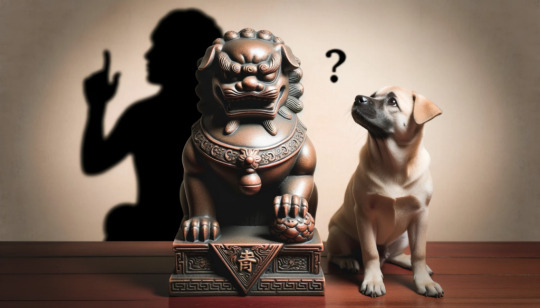
Despite the well-documented history of Fu Dogs in Chinese culture and tradition, there exists a lesser-known fact that ceramic sculptures of these creatures carry a unique significance. When Fu Dog statues first appeared, they were made from bronze, stone, or wood, attributing to both the artistry and the resources available during the different dynasties. However, the craft saw a significant revolution at the onset of the Tang dynasty when foo dogs ceramic gained widespread popularity.
The rise in the foo dogs ceramic during the Tang dynasty is said to be due to the technological advancements in pottery, and ceramics at that time. Simultaneously, this trend reflected the increasing openness of Tang society, gradually moving away from the rigidly hierarchical Shang and Zhou societies and expressing this liberal phase through its art forms.
This historical shift, though quite compelling, is often understated, possibly because it disrupts the more engrained narrative of Fu Dogs as symbols of imperial power and authority. Instead, it highlights a period of evolution, when societal changes influenced art and culture in profound ways. This transformation is encapsulated in the transition from using traditional materials to ceramics for Fu Dog statues, a fact intriguingly unknown to many.
Fu Dog Design and Craftsmanship

Fu Dog Statues are distinguished by a meticulously detailed design and superior craftsmanship. This intricacy can be attributed to the centuries-old Chinese tradition of stone carving and pottery-making. The exquisite detail of Fu Dogs, from their curly mane to the wide-open jaws displaying sharp teeth, embodies not just aesthetics, but also folklore and mysticism tied to the creature.
The common physical features of Fu Dogs include a lion-like appearance, a bushy tail, and a protective and fierce demeanor. Often the Fu Dog sculpture depicts a pair, comprising one male with a ball under his paw (symbolizing the world's unity) and one female, with a cub under her paw (symbolizing nurture and the cycle of life).
Stylistic variations of Fu Dogs vary greatly based on region and era. Despite this, elements like the paw on the symbolic objects, aggressive expressions, and muscular, lion-like bodies remain constant in traditional designs. Fu Dogs are typically carved from marble, jade, bronze, or wood. Every material has its own significance, from purity symbolized by Jade to strength and durability associated with Bronze and Wood.
Sometimes the statues are enhanced with more detailed ornamentation, Oftentimes, the statues are painted or gilded to make them more visually striking. These intricacies in design and craftsmanship highly contribute to Fu Dogs' appreciation as exquisite pieces of art and cultural symbols.
Common Physical Features

Fu Dog statues are typically portrayed as majestic and ferocious mythical beasts, reflecting a harmonious blend of strength, elegance, and spirituality. The most universally recognized physical attributes consist of a bulging, muscular body, thick mane, and widely-opened jaws that reveal sharp, imposing teeth. They are typically shown with one foot raised and placed on an object. This object varies - it might be a cub depicting nurturance if the creature is female, or a ball symbolizing command and authority if the creature is male.
Coupled with the captivating presence of finely detailed fur, the piercing eyes of Fu Dogs contribute to their grandiosity, giving them an aura of wisdom curled with intensity. Another characteristic element of Fu Dogs is the vibrant and intricate adornments and the surface etchings on them.
Read the full article
#ancientChina#artandarchitecture#Asianart#Chineseculture#ChineseGuardianLions#Chinesemythology#culturalheritage#Easternphilosophies#FengShui#FuDogStatues#FuDogStatueshistory#globalinfluence#guardianlions#HanDynasty#TangDynasty
1 note
·
View note
Photo

Imperial or Chinese guardian lions, also referred to as lion dogs or foo dogs in English, are a traditional Chinese architectural ornament. Typically they are made of stone which earned the nickname stone lions or shishi. The traditional concept, which originated and widely became popular in Chinese Buddhism, features a pair of highly stylized and detailed lions—often one male with a ball and one female with a cub—which were thought to protect the building or structure from harmful spiritual influences. They were used near imperial Chinese palaces and tombs, the lions subsequently spread to other parts of Asia. These wonderful heritage lions will be restored and will remain as guardians of this restoration project. #chinese #guardianlions #heritage #stone #imperial #shishi #asia #ornament #buddhism #heritage #Vancouver #restoration #vancity #vancitybuzz #myyvr #604 #604now #georgiastraight #bc #vancouverrenovations #vancouverbiz #vancouverbc #dailyhivevan #vancouver_canada #vancouvergram #vancouverisawesome #vancouverreno (at Arbutus Greenway) https://www.instagram.com/p/B5H6M0hhRsB/?igshid=z7z8jp4jbsmc
#chinese#guardianlions#heritage#stone#imperial#shishi#asia#ornament#buddhism#vancouver#restoration#vancity#vancitybuzz#myyvr#604#604now#georgiastraight#bc#vancouverrenovations#vancouverbiz#vancouverbc#dailyhivevan#vancouver_canada#vancouvergram#vancouverisawesome#vancouverreno
0 notes
Photo

JD on her 7579123rd redesign, trying to bond with her Digimon - I mean LOYAL PROTECTOR, Apples. ((You're embarrassing me, human.))
#apples#jd#portrait#art#celshade#hugs#papertiger#foodog#guardianlion#shisa#harseik#firesiders#shieldoffaith#letmeloveyou#keeper#companion#creaturedesign#iwoulddie4u#petstagram#artwork
29 notes
·
View notes
Text

Kilin (Kirin?) Blind Box Figure by MO JI - Secret Color!
I’ve already posted this dude once- but this pic is Better
#collection #collectables #toy #toys #toycollector #collectabletoys #artcollectables #instatoy #toystagram #toyphotography #monster #monsters #sculpture #chineselion #foodog #shishi #vinyl #guardianlion #mythology #blindbox #kirin #moji #kilin
4 notes
·
View notes
Photo

Guardian lions also known as lion-dogs or foo dogs. They are traditional symbols of power and protection found guarding not only temples but also institutions of consequence in China, including banks, government offices, and hotels. They are generally known in Chinese as 'stone lions'(shíshī). The lions come in pairs, one male and one female. Viewed from the outside, the female is usually on the left and the male on the right. Conventionally, the male has his paw on a ball and the female has hers on a lion cub. if you have any interest about stone lions you can ask to me. #guardianlions #liondogs #foodogs #stonelions #shishi #granitelions #lionsculpture #granitesculpture #stonesculpture #winson #Xiamen #china (at Xiamen, Fujian) https://www.instagram.com/p/BwtCnX0lnNJ/?utm_source=ig_tumblr_share&igshid=1mhbirvjf5fxk
#guardianlions#liondogs#foodogs#stonelions#shishi#granitelions#lionsculpture#granitesculpture#stonesculpture#winson#xiamen#china
0 notes
Photo

foodog
Posted using PostyBirb
2 notes
·
View notes
